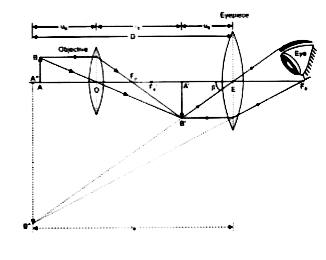(a) Draw a labelled ray diagram showing the formation of a final image by a compound microscope at least distance of distinct vision.
(b) The total magnification produced by a compound microscope is 20. The magnification produced by the piece is 5. The microscope is focussed on a certain object. The distance between the objective and eyepiece is observed to be 14cm. If least distance of distinct vision is 20cm, calculate the focal length of the objective and the eye piece.
Topper's Solved these Questions
- BOOK - CBSE COMPLEMENTARY MATERIALCHAPTER - CBSE Examination Paper Delhi–2014EXERCISE - Set-II (Questions Uncommon to Set-I)10videos
CBSE Examination Paper Delhi–2014
- BOOK - CBSE COMPLEMENTARY MATERIALCHAPTER - CBSE Examination Paper Delhi–2014EXERCISE - SET-III (Questions Uncommon to set-I and II)9videos
CBSE Examination Paper Delhi–2014
- BOOK - CBSE COMPLEMENTARY MATERIALCHAPTER - CBSE EXAMINATION PAPER - 2016 EXERCISE - SECTION - E17videos
CBSE EXAMINATION PAPER - 2016
- BOOK - CBSE COMPLEMENTARY MATERIALCHAPTER - CBSE EXAMINATION PAPER, DELHI REGION - 2015 (CODE NO. 55/1/1/D)EXERCISE - SECTION E6videos
CBSE EXAMINATION PAPER, DELHI REGION - 2015 (CODE NO. 55/1/1/D)
Similar Questions
(a) Draw a labelled ray diagram showing the formation of a final image by a compound microscope at least distance of distinct vision.
(b) The total magnification produced by a compound microscope is 20. The magnification produced by the eyepiece is 5. The microscope is focussed on a certain object. The distance between the objective and eyepiece is observed to be 14 cm. If least distance of distinct vision is 20 cm, calculate the focal length of the objective and the eyepiece.View SolutionThe total magnification produced by a compound microscope is 20. The magnification produced by the eye piece is 5. The microscope is focussed on a certain object. The distance between the objective and eye piece is observed to be 14cm. If least distance of distinct vision is 20cm, calculate the focal length of objective and eye piece.
View Solution
Knowledge Check
- Question 1 - Select One
The least distance of distinct vision is
A35 cmB25 cmC45 cmD15 cm - Question 2 - Select One
The least distance of distinct vision is
A2.5cmB25 cmC2.5mD25 m - Question 3 - Select One
In a compound microscope the image produced by the objective is
Areal enlarged and errectBreal enlarged and invertedCVirtual enlarged and erectDVirtual, enlarged and inverted
The total magnification produced by a compound microscope is 20. The magnification produced by the eye piece is 5. The microscope is focussed on a certain object. The distance between the objective and eye piece is observed to be 14cm. If least distance of distinct vision is 20cm, calculate the focal length of objective and eye piece.
View SolutionDraw a labelled diagram showing image formation by a simple microscope when the image is being formed at least distance of its distinct vision. Find an expression for its angular magnification (or the magnifying power.
View SolutionDraw a ray diagram showing the image formation by a compound microscope. Hence, obtain expression for total magnification when the image is formed at infinity.
View SolutionIn a compound microscope in normal adjustment magnification and produced by objective lens is 10 cm magnification produced by the eyepiece is 8. Magnification of microscope is ________.
View SolutionFor a total magnification of 175 from a compound microscope, the magnification produced by objective is 7. What should be the magnification produced by eye piece ?
View Solution


